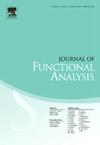Almost Auerbach, Markushevich and Schauder bases in Hilbert and Banach spaces
IF 1.7
2区 数学
Q1 MATHEMATICS
引用次数: 0
Abstract
For any sequence of positive numbers such that we provide an explicit simple construction of -bounded Markushevich basis in a separable Hilbert space which is not strong, or, in other terminology, is not hereditary complete; this condition on the sequence is sharp. Using a finite-dimensional version of this construction, Dvoretzky's theorem and a construction of Vershynin, we conclude that in any Banach space for any sequence of positive numbers such that there exists a -bounded Markushevich basis which is not a Schauder basis after any permutation of its elements.
几乎在希尔伯特和巴拿赫空间中都有奥尔巴赫,马库舍维奇和绍德的基地
对于任意正数序列(εn)n=1∞使得∑n=1∞εn=∞,我们给出了可分离Hilbert空间中(1+εn)有界Markushevich基的显式简单构造,该构造不是强的,或者换句话说,不是遗传完全的;这个条件对于序列(εn)n=1∞是尖锐的。利用该构造的有限维版本,Dvoretzky定理和Vershynin的构造,我们得到了在任意Banach空间中,对于任意正数序列(εn)n=1∞使得∑n=1∞εn2=∞,存在一个(1+εn)有界的Markushevich基,该基在其元素的任意排列后都不是Schauder基。
本文章由计算机程序翻译,如有差异,请以英文原文为准。
求助全文
约1分钟内获得全文
求助全文
来源期刊
CiteScore
3.20
自引率
5.90%
发文量
271
审稿时长
7.5 months
期刊介绍:
The Journal of Functional Analysis presents original research papers in all scientific disciplines in which modern functional analysis plays a basic role. Articles by scientists in a variety of interdisciplinary areas are published.
Research Areas Include:
• Significant applications of functional analysis, including those to other areas of mathematics
• New developments in functional analysis
• Contributions to important problems in and challenges to functional analysis

 求助内容:
求助内容: 应助结果提醒方式:
应助结果提醒方式:


